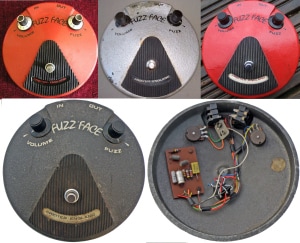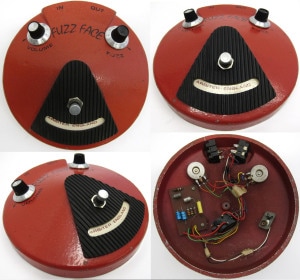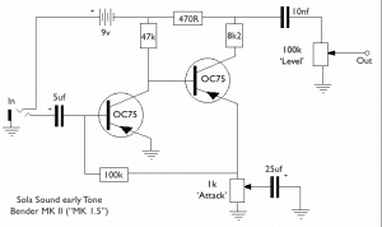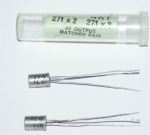The following text was NOT written by Sonus Pedals. Instead it was a Wordpress page saved some time ago that has since been taken offline. I don't know who wrote it, as there was no name mentioned, only a nickname; JVGthirteen. So thank you! whoever you are!!!

The Arbiter Fuzz Face 1966-68
The original NKT 275 transistor version
The Fuzz Face’s appearance in Autumn 1966 – and Hendrix’s almost immediate use of it (an interesting confluence):
The earliest known units have potentiometer codes dating to September and October 1966. Components may linger in storage for some time before they’re used in a circuit of course – but not in this instance. Jimi was photographed using a Fuzz Face in November 1966 (and wearing a very groovy pair of trousers).The photo is from one of the three or four nights the Experience played at the Big Apple in Munich in the second week of November 66 – one of their earliest performances. Jimi had only arrived in London on the 24th September 66. The Experience were formed and made their debut just two weeks later (supporting the Johnny Hallyday tour in Evreux, France on the 13th October 66). At some point in the hectic early days of the Experience, Hendrix had evidently come across the new-fangled Fuzz Face in a London guitar shop and must have liked what he heard.
The Experience recorded Hey Joe in late October and Stone Free at the start of November, just before they left for the Big Apple gigs in Munich. In late November, back in London, they returned to the studio to record Love or Confusion. The ending of Stone Free may be, if I’m hearing things right, the first use of a Fuzz Face by Hendrix on record (specifically the unexpected shift to a fuzzy F-chord and fade out at about 3:30mins). In Love or Confusion Jimi certainly does use a fuzz box on some of the guitar tracks. Presumably this was his Fuzz Face.
The original NKT 275 transistor version
The Fuzz Face’s appearance in Autumn 1966 – and Hendrix’s almost immediate use of it (an interesting confluence):
The earliest known units have potentiometer codes dating to September and October 1966. Components may linger in storage for some time before they’re used in a circuit of course – but not in this instance. Jimi was photographed using a Fuzz Face in November 1966 (and wearing a very groovy pair of trousers).The photo is from one of the three or four nights the Experience played at the Big Apple in Munich in the second week of November 66 – one of their earliest performances. Jimi had only arrived in London on the 24th September 66. The Experience were formed and made their debut just two weeks later (supporting the Johnny Hallyday tour in Evreux, France on the 13th October 66). At some point in the hectic early days of the Experience, Hendrix had evidently come across the new-fangled Fuzz Face in a London guitar shop and must have liked what he heard.
The Experience recorded Hey Joe in late October and Stone Free at the start of November, just before they left for the Big Apple gigs in Munich. In late November, back in London, they returned to the studio to record Love or Confusion. The ending of Stone Free may be, if I’m hearing things right, the first use of a Fuzz Face by Hendrix on record (specifically the unexpected shift to a fuzzy F-chord and fade out at about 3:30mins). In Love or Confusion Jimi certainly does use a fuzz box on some of the guitar tracks. Presumably this was his Fuzz Face.
|
Some great footage of the Experience playing on a German TV show in 1967 shows how Hendrix was making use of a Fuzz Face live at that time (thickening up and roughing up lead guitar parts in particular). I think it also gives an idea of what the original fuzz face could sound like and, therefore, what to expect. |
|
Some pictures of 1966/67 Fuzz Faces:

1968 and the change from Arbiter to the Dallas-Arbiter brand:
A second, slightly different sand-cast enclosure appeared in '68 (pot codes in these date to May and October 1968 I gather). The flattened ‘arc’ at the top of the pedal (in which the jack sockets fit) is ever so slightly shorter in length than in the 66-67 pedals. On the inside of the enclosure a third ‘flattened disc’ was added in-between those already there for the volume and fuzz potentiometers. This additional ‘disc’ was seemingly to facilitate building of Arbiter’s three knobbed ‘Treble-Plus-Bass Face’ – a booster pedal housed in the same enclosure. During 1968 ‘Dallas-Arbiter’ replaced Arbiter as the brand name on the Fuzz Face. J.E. Dallas and Sons Ltd had bought out the smaller Arbiter enterprise, but not entirely subsumed it, and the Dallas-Arbiter brand eventually came into being. Ivor Arbiter, the founder of the Arbiter Group, recalled the merger with Dallas as follows: “They [Dallas] made £34 in 1966, £55 in 1967 – that was their profit record. I joined and, after the first year, £72,000, then £75,000, then £375,000. They soon changed the name to Dallas-Arbiter!” [The Telegraph Obituary, 2005]. Ivor Arbiter, so the story goes, was responsible for the unique look of the Fuzz Face. He was certainly responsible for the Beatles famous dropped-T logo. One day in 1963 Ringo Starr and Brian Epstein turned up at Arbiter’s Drum City shop looking to buy a new kit. They asked for the band’s name be painted on the bass drum head. Arbiter sketched an idea the pair were happy with, passed it to the artist he brought in for such work, and the rest is history.
A second, slightly different sand-cast enclosure appeared in '68 (pot codes in these date to May and October 1968 I gather). The flattened ‘arc’ at the top of the pedal (in which the jack sockets fit) is ever so slightly shorter in length than in the 66-67 pedals. On the inside of the enclosure a third ‘flattened disc’ was added in-between those already there for the volume and fuzz potentiometers. This additional ‘disc’ was seemingly to facilitate building of Arbiter’s three knobbed ‘Treble-Plus-Bass Face’ – a booster pedal housed in the same enclosure. During 1968 ‘Dallas-Arbiter’ replaced Arbiter as the brand name on the Fuzz Face. J.E. Dallas and Sons Ltd had bought out the smaller Arbiter enterprise, but not entirely subsumed it, and the Dallas-Arbiter brand eventually came into being. Ivor Arbiter, the founder of the Arbiter Group, recalled the merger with Dallas as follows: “They [Dallas] made £34 in 1966, £55 in 1967 – that was their profit record. I joined and, after the first year, £72,000, then £75,000, then £375,000. They soon changed the name to Dallas-Arbiter!” [The Telegraph Obituary, 2005]. Ivor Arbiter, so the story goes, was responsible for the unique look of the Fuzz Face. He was certainly responsible for the Beatles famous dropped-T logo. One day in 1963 Ringo Starr and Brian Epstein turned up at Arbiter’s Drum City shop looking to buy a new kit. They asked for the band’s name be painted on the bass drum head. Arbiter sketched an idea the pair were happy with, passed it to the artist he brought in for such work, and the rest is history.
The origin of the Fuzz Face circuit – the early Sola Sound Tone Bender MK II: The circuit found in the Fuzz Face appeared first in a competitor’s product, the early version of Sola Sound’s Tone Bender MKII. That appeared earlier in 1966(left schematic). The circuit was soon altered by Sola Sound – or perhaps more accurately one of the consultant boffins Sola Sound utilised. An extra gain stage was added to the front of the circuit (increasing sustain and distortion). The revised, three-transistor version is now acknowledged as the Tone Bender MK II circuit (the original, two-transistor version is generally referred to as the “MK 1.5” nowadays to differentiate it).How Arbiter came by the earlier version for their own fuzz box is not known (perhaps they simply opened up and copied an early MK II).
The Arbiter circuit – the ‘standard’ one and at least one slight variation. The following schematic is considered standard for the original Fuzz Face. As can be seen, Arbiter adjusted the Sola Sound circuit a little(right schematic):
The Arbiter circuit – the ‘standard’ one and at least one slight variation. The following schematic is considered standard for the original Fuzz Face. As can be seen, Arbiter adjusted the Sola Sound circuit a little(right schematic):
As well as opting for a different choice in transistor (the Newmarket NKT 275), Arbiter went with a 470k volume pot instead of a 100k pot. This has a significant impact on the sound of the circuit. One reason for this is ‘stray capacitive loading’. Simply put, the volume pot is a voltage divider (that encounters an AC signal only). If the pot is set to 12 o’clock (half-way) then a 100k ohms pot places 50k ohms series resistance on the output of the circuit. A 470k ohms pot would place 235k ohms series resistance on the output. The cable plugged into the output jack of the Fuzz Face and running to the amp will have inevitable internal capacitance. The series resistance of the volume pot in conjunction with the capacitance of the cable forms a high-pass filter. The bigger the output resistance (and cable capacitance) the bigger the high frequency loss. Ergo the 100k pot results in less high frequency roll off. The 470k pot results in greater high frequency loss and a ‘darker’ sounding fuzz.
The NKT 275 and transistor Beta/Hfe and matching: The only germanium transistor used by Arbiter in the Fuzz Face was the Newmarket NKT 275. Original ‘NOS’ Newmarket transistors in general will be expensive if you can find them – but especially the 275. People have been hunting them down for decades because of the association with the original Fuzz Face.
The NKT 275 is a positive ground (PNP), audio frequency transistor with a nominal Hfe (Beta) range of 30-90. The Hfe is not only low compared to typical silicon transistors, but also compared to quite a few later generation PNP germanium transistors.
The following measurements of transistors found in vintage Fuzz Faces I stumbled on when nosing around the D*A*M stompboxes forum. (If I remember right, David Main himself and ‘fuzzface6669’ generously provided the measurements and suggestions; both seem very decent blokes and both have plenty of experience working on vintage Fuzz Faces as well as building them):
The NKT 275 and transistor Beta/Hfe and matching: The only germanium transistor used by Arbiter in the Fuzz Face was the Newmarket NKT 275. Original ‘NOS’ Newmarket transistors in general will be expensive if you can find them – but especially the 275. People have been hunting them down for decades because of the association with the original Fuzz Face.
The NKT 275 is a positive ground (PNP), audio frequency transistor with a nominal Hfe (Beta) range of 30-90. The Hfe is not only low compared to typical silicon transistors, but also compared to quite a few later generation PNP germanium transistors.
The following measurements of transistors found in vintage Fuzz Faces I stumbled on when nosing around the D*A*M stompboxes forum. (If I remember right, David Main himself and ‘fuzzface6669’ generously provided the measurements and suggestions; both seem very decent blokes and both have plenty of experience working on vintage Fuzz Faces as well as building them):
- Hfe is always quite low in the NKT 275 Fuzz Face; few transistors if any exceeding 70 Hfe.
- The pairs are closely matched in Hfe.
- One reportedly good sounding unit had a pair of transistors each measuring 56Hfe exactly.
- Another reportedly good sounding original had a Q1 with Hfe in the low to mid 50s and a Q2 that measured c. 69 Hfe. Leakage wasn’t particularly low in these transistors.
It is probably common knowledge by now, but germanium transistors are notably temperature sensitive, a facet that has the potential to make a fuzz circuit using them capricious. Both current gain and leakage of a germanium transistor increase with heat. Ergo changes in climate, season, or just the weather will have some impact on the performance of a device. Voltages and bias points within a circuit designed around germanium transistors will vary as the current gain and leakage of those transistors fluctuates. Small variations should not make an appreciable difference to the functioning of a circuit. But they may mean a germanium Fuzz Face sounds a little different depending on the season and temperature. In the heat of summer or hot locations generally it is possible for a germanium Fuzz Face built in the temperate (i.e. grey and soggy) UK to re-bias itself from an optimal point (and possibly even choke and stop working, or so I’ve read… I live in the too often sunless and soggy UK).












